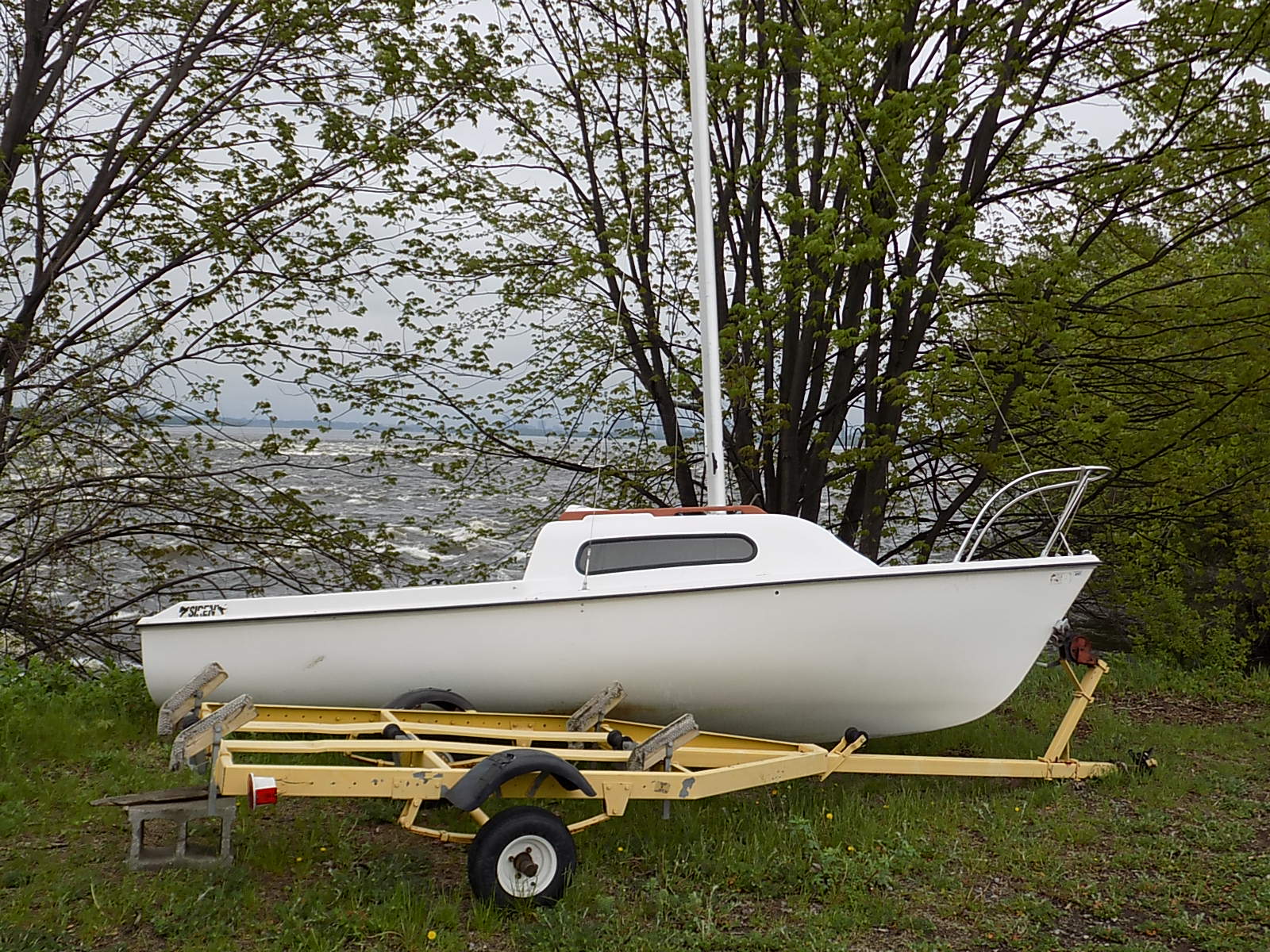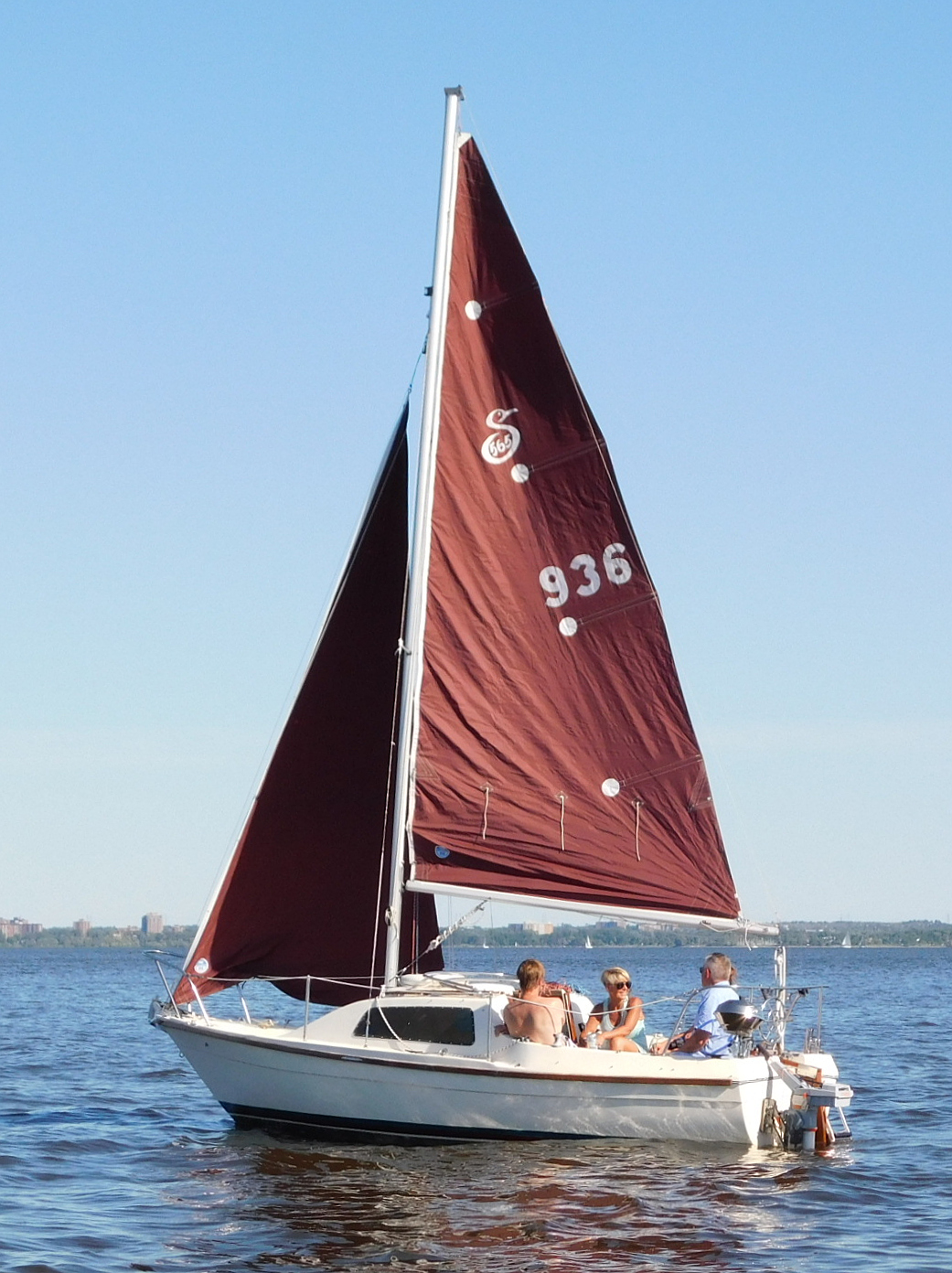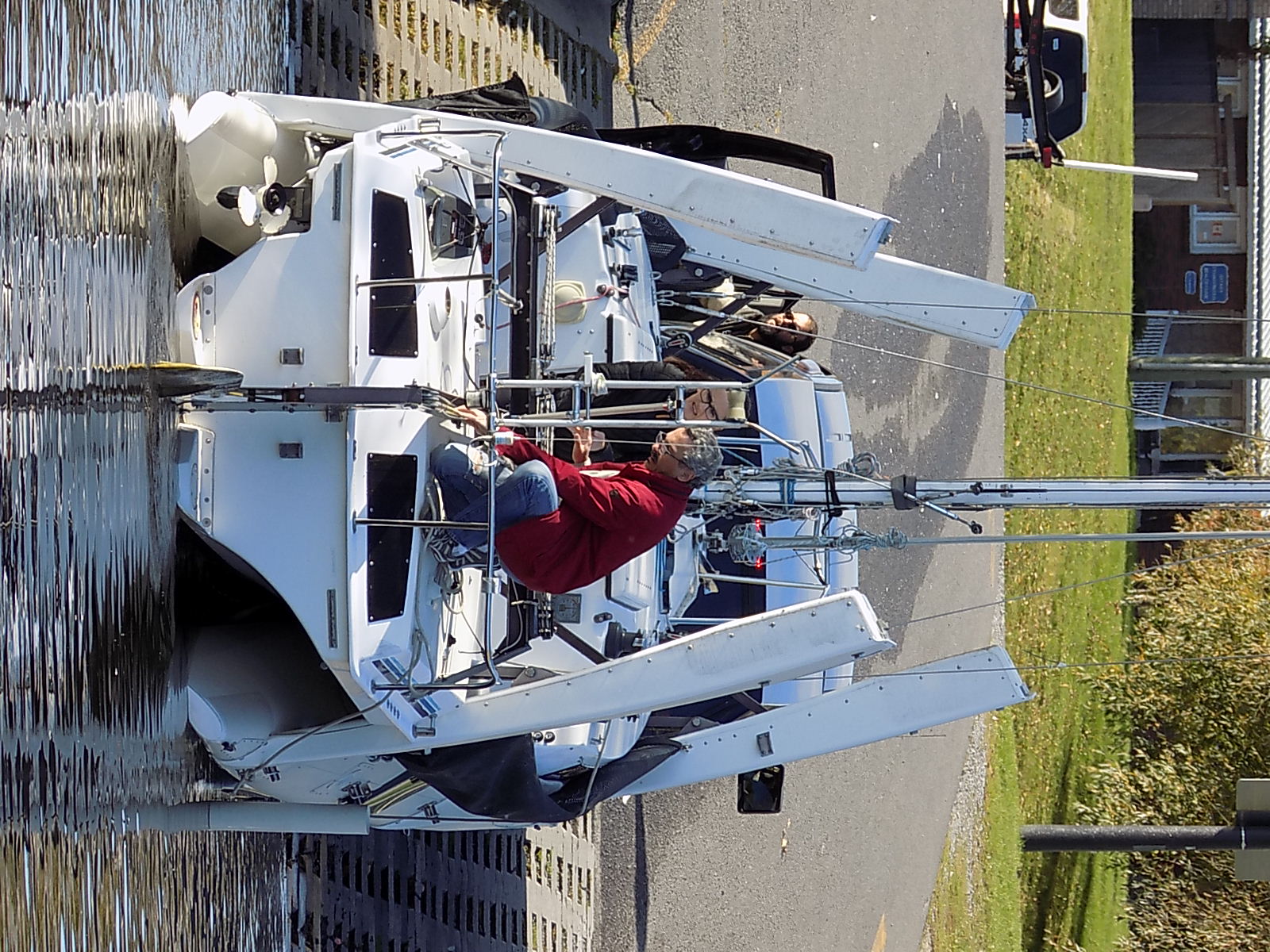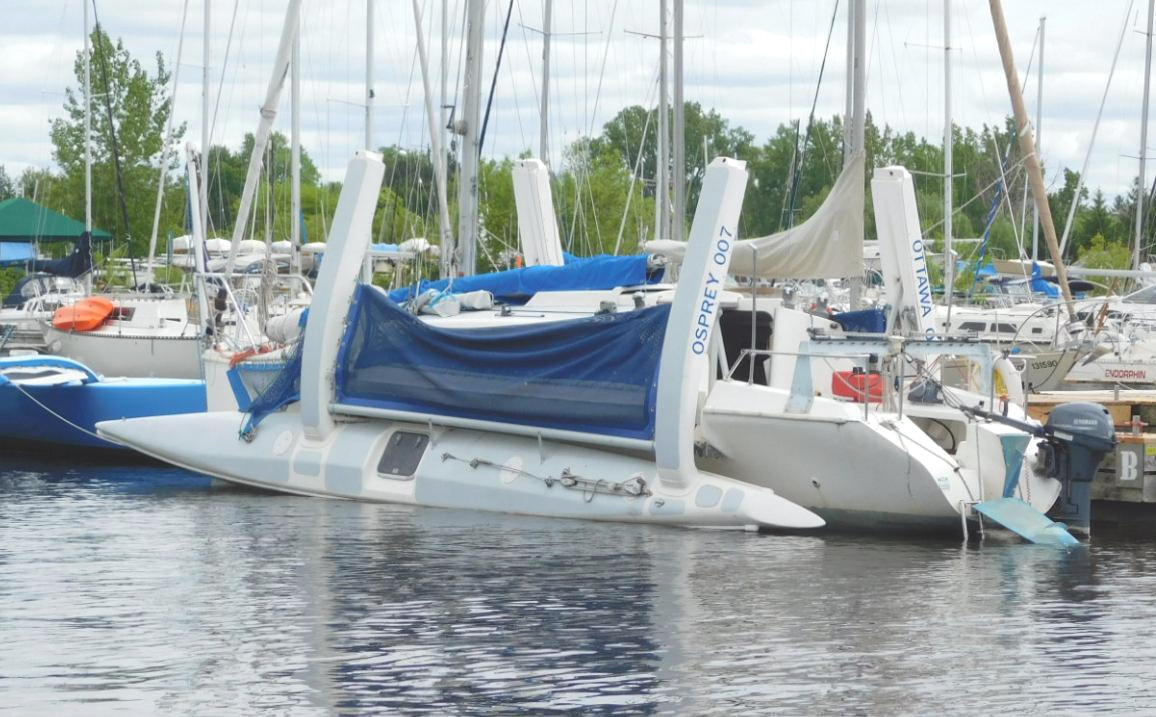Trailer Yacht on:
[Wikipedia]
[Google]
[Amazon]
 A trailer sailer is a type of sailboat that has been designed to be easily transported using a
A trailer sailer is a type of sailboat that has been designed to be easily transported using a
 The first trailer sailers were built in the 1950s. They were light, marine plywood boats designed for home builders. Robert Tucker in the UK designed the Silhouette, in the early 1950s. His concept was to build a small boat suitable for overnight camping, which could be trailed to different locations behind a small car. It is thought that over 3000 of this type have been built. In the mid-1950s, Richard Hartley of New Zealand designed the Hartley TS16, a 16 ft long trailer sailer with a towing weight of . The TS16 was built in large numbers in New Zealand and Australia, spurring the popularity of trailer sailers in these countries. Over 12,000 boats of this type have been built.
The advent of mass production fibreglass boats in the mid 1960s saw an expansion of trailer sailer designs, such as the
The first trailer sailers were built in the 1950s. They were light, marine plywood boats designed for home builders. Robert Tucker in the UK designed the Silhouette, in the early 1950s. His concept was to build a small boat suitable for overnight camping, which could be trailed to different locations behind a small car. It is thought that over 3000 of this type have been built. In the mid-1950s, Richard Hartley of New Zealand designed the Hartley TS16, a 16 ft long trailer sailer with a towing weight of . The TS16 was built in large numbers in New Zealand and Australia, spurring the popularity of trailer sailers in these countries. Over 12,000 boats of this type have been built.
The advent of mass production fibreglass boats in the mid 1960s saw an expansion of trailer sailer designs, such as the
 Cabins in trailer sailers are usually arranged with dual purpose settee- berths running along the side of the boat from a V-berth at the bow, to quarter berths underneath the
Cabins in trailer sailers are usually arranged with dual purpose settee- berths running along the side of the boat from a V-berth at the bow, to quarter berths underneath the
 Trailer sailers, by necessity, must be transported by trailer, which places a number of restrictions on their design. To make them easy to launch, retrieve and transport by trailer, boats cannot have long fixed keels. Therefore, most trailer sailers have swing keel centreboards or
Trailer sailers, by necessity, must be transported by trailer, which places a number of restrictions on their design. To make them easy to launch, retrieve and transport by trailer, boats cannot have long fixed keels. Therefore, most trailer sailers have swing keel centreboards or
 Most trailer sailers use a
Most trailer sailers use a
 Trailer sailers usually have a motor for docking and maneuvering. Most trailer sailers use outboard motors, which are best suited to sailboats 28 ft in length and under. Outboards offer the advantage of being light, easy to use and maintain and are also inexpensive, as they are commercially produced on a large scale and sold off-the-shelf. They can also be raised out of the water, to eliminate drag when sailing. This contrasts with inboard diesel engines which are heavy and occupy significant internal space and are best suited to larger vessels.
Outboard motors used for trailer sailers need to be geared down as trailer sailers sail at slow displacement speeds compared to the higher planing speeds of powerboats, which are the most common application for outboard motors. Outboards are often mounted on the
Trailer sailers usually have a motor for docking and maneuvering. Most trailer sailers use outboard motors, which are best suited to sailboats 28 ft in length and under. Outboards offer the advantage of being light, easy to use and maintain and are also inexpensive, as they are commercially produced on a large scale and sold off-the-shelf. They can also be raised out of the water, to eliminate drag when sailing. This contrasts with inboard diesel engines which are heavy and occupy significant internal space and are best suited to larger vessels.
Outboard motors used for trailer sailers need to be geared down as trailer sailers sail at slow displacement speeds compared to the higher planing speeds of powerboats, which are the most common application for outboard motors. Outboards are often mounted on the
 A trailer sailer is a type of sailboat that has been designed to be easily transported using a
A trailer sailer is a type of sailboat that has been designed to be easily transported using a boat trailer
A boat trailer is designed to launch, retrieve, carry and sometimes store boats.
Commercial boat trailers
Commercial hydraulic boat trailers are used by marinas, boat yards, boat haulers, boat dealers and boat builders. Generally this type ...
towed by an automobile. They are generally larger than a sailing dinghy.Royce, Patrick M.: ''Royces Sailing Illustrated'', pages 52-57. Delta Lithograph, 1993. Trailer sailers include day sailers and small cabin cruisers, suitable for living on.
Trailer sailers are used for both racing and recreation and are popular with small families and retirees. They occupy a space between smaller trailerable sailing dinghies which are intended for day use and larger boats which can only be removed from the water with specialised equipment such as boat lifting cranes.
Unlike dinghies, many feature enclosed cabins which allow for overnight sleeping and dry storage. Most trailer sailers also feature ballast, either fixed or in a swinging centreboard or dagger board
A daggerboard is a retractable centreboard used by various sailing craft. While other types of centreboard may pivot to retract, a daggerboard slides in a casing. The shape of the daggerboard converts the forward motion into a windward lift, cou ...
to make them easier to launch and retrieve. This makes these boats more stable than a dinghy, as well as less prone to capsize and more capable of self-righting. Sails on trailer sailers can also be lowered easily on water unlike dinghies which are often rigged fully on the shore.
Trailer sailers offer a number of advantages over larger boats that are impractical to tow on a trailer. Because they can be towed and stored at home, owners can avoid the mooring fees and maintenance costs of boats that remain in the water. Towing is also a relatively fast and efficient way of reaching new destinations from which to sail. However, they generally have less living space. All but the biggest do not have standing room in their cabins. Moreover, trailer sailers are generally more lightly-built and ballasted, making them incapable of tackling open oceans, confining them to coastal and protected waters.
Due to the limitations of trailer capacity, towing vehicle size and weight, as well as highway width limitations, most trailer sailboats are limited in size to about in length and beams of .
History
 The first trailer sailers were built in the 1950s. They were light, marine plywood boats designed for home builders. Robert Tucker in the UK designed the Silhouette, in the early 1950s. His concept was to build a small boat suitable for overnight camping, which could be trailed to different locations behind a small car. It is thought that over 3000 of this type have been built. In the mid-1950s, Richard Hartley of New Zealand designed the Hartley TS16, a 16 ft long trailer sailer with a towing weight of . The TS16 was built in large numbers in New Zealand and Australia, spurring the popularity of trailer sailers in these countries. Over 12,000 boats of this type have been built.
The advent of mass production fibreglass boats in the mid 1960s saw an expansion of trailer sailer designs, such as the
The first trailer sailers were built in the 1950s. They were light, marine plywood boats designed for home builders. Robert Tucker in the UK designed the Silhouette, in the early 1950s. His concept was to build a small boat suitable for overnight camping, which could be trailed to different locations behind a small car. It is thought that over 3000 of this type have been built. In the mid-1950s, Richard Hartley of New Zealand designed the Hartley TS16, a 16 ft long trailer sailer with a towing weight of . The TS16 was built in large numbers in New Zealand and Australia, spurring the popularity of trailer sailers in these countries. Over 12,000 boats of this type have been built.
The advent of mass production fibreglass boats in the mid 1960s saw an expansion of trailer sailer designs, such as the Aquarius 21
The Aquarius 21 is an American trailerable sailboat that was designed by Peter Barrett as a cruiser and first built in 1969.Henkel, Steve: ''The Sailor's Book of Small Cruising Sailboats'', page 81. International Marine/McGraw-Hill, 2010.
T ...
Boomerang 20
The Boomerang 20 is a sailboat that was designed by Eric Maizey in the late 1960s to race and cruise on Port Phillip in Melbourne Australia, sheltered water but choppy conditions. The original boats were built at the family home in Frankston wi ...
, Cal 21
The Cal 21 is an American Trailer sailer, trailerable sailboat that was designed by C. William Lapworth as a Cruising (maritime), cruiser and first built in 1969.Henkel, Steve: ''The Sailor's Book of Small Cruising Sailboats'', page 90. Interna ...
, Careel 18, Neptune 16, and Pearson 22. The Catalina 22,launched in 1969, is particularly notable as it continues in production, with over 15,000 built.
Trailer cabin sailboats appeared on the US market in 1970 and were sailed on small lakes and rivers. A large number were initially sold in North America in areas such as Arizona, New Mexico and the Great Lakes region.
In the late 1980s and early 1990s trailer sailers evolved into sportsboats, of a similar size but more optimised for racing speed with reduced accommodation and lightweight hulls. There is an absence of an accepted definition of the term.
Accommodation
 Cabins in trailer sailers are usually arranged with dual purpose settee- berths running along the side of the boat from a V-berth at the bow, to quarter berths underneath the
Cabins in trailer sailers are usually arranged with dual purpose settee- berths running along the side of the boat from a V-berth at the bow, to quarter berths underneath the cockpit
A cockpit or flight deck is the area, usually near the front of an aircraft or spacecraft, from which a Pilot in command, pilot controls the aircraft.
The cockpit of an aircraft contains flight instruments on an instrument panel, and the ...
. Usually, the centreboard or daggerboard trunk encroaches into the cabin in the middle of the boat, but can form the base for a folding table. Some types have a small four person table with club seating. Boats may or may not have a small galley
A galley is a type of ship that is propelled mainly by oars. The galley is characterized by its long, slender hull, shallow draft, and low freeboard (clearance between sea and gunwale). Virtually all types of galleys had sails that could be used ...
with a stove, a food preparation area and a sink. In terms of headroom, the smallest types do not have sitting head room for taller sailors, while only the largest have standing headroom. Some boats address this problem using cabin pop-tops that can be raised when not underway to provide additional head room.
The smallest trailer sailers in the range generally have two berths. As boats become larger four berths are commonly fitted, with a V-berth at the bow and quarter berths at the rear. Larger boats might have up to six berths. Many trailer sailers have a small galley with a stove, built in, although on smaller trailer sailers, this may be omitted. Usually, trailer sailers have a head
A head is the part of an organism which usually includes the ears, brain, forehead, cheeks, chin, eyes, nose, and mouth, each of which aid in various sensory functions such as sight, hearing, smell, and taste. Some very simple animals may ...
, which is most commonly a portable toilet, mounted in the bow V-berth area of the cabin. Some larger boats however have an enclosed toilet.
Towing
 Trailer sailers, by necessity, must be transported by trailer, which places a number of restrictions on their design. To make them easy to launch, retrieve and transport by trailer, boats cannot have long fixed keels. Therefore, most trailer sailers have swing keel centreboards or
Trailer sailers, by necessity, must be transported by trailer, which places a number of restrictions on their design. To make them easy to launch, retrieve and transport by trailer, boats cannot have long fixed keels. Therefore, most trailer sailers have swing keel centreboards or daggerboard
A daggerboard is a retractable centreboard used by various sailing craft. While other types of centreboard may pivot to retract, a daggerboard slides in a casing. The shape of the daggerboard converts the forward motion into a windward lift, cou ...
s.
Generally a trailer sailer should be towable behind a vehicle without special licences for oversized loads. This means that the beam is usually limited to approximately depending on jurisdiction. The practical limit for the length of such boats is , although some trailer sailers such as the Robb Legg 28
Robb is a surname of Scottish origin, formed from a diminution (reduction) of the name Robert. Robert was a popular name, especially after its use by three Scots Kings in the fourteenth century. Rob is first recorded as a surname in the mid-15th ...
or the Gougeon 32 are longer. Weight limitations are determined by the towing vehicle. Smaller trailer sailers can weigh or less and can easily be towed behind average cars, while larger, heavily ballasted trailer sailers can weigh over require heavy vehicles with specialised towing equipment. Larger trailer sailers over 26 ft are difficult to tow and are sometimes kept in the water and only placed on their trailers for occasional towing or storage.
Trailer sailer masts must be lowered for towing. This becomes difficult on larger boats with heavier, longer masts. Such boats require complex mast raising systems.
Some sailboat designs for trailering incorporate special features. The MacGregor 26S
The MacGregor 26 is an American trailerable sailboat, that was designed by Roger MacGregor and first built in 1986, with production ending in 2013.
The boat was built by MacGregor Yacht Corporation in the United States.
The design was develo ...
, for example is a boat in length, but that weighs empty and dry and carries of flooding water ballast in tanks which are filled when the boat is launched and drained when the boat is removed from the water, thus making the boat lighter to transport than if it used more traditional iron or lead ballast. The design also has a pivoting centreboard, plus a pivoting rudder and easily rigged mast to make getting the boat from the trailer to the water easy to accomplish. It also has a beam of , under the width limit for highway trailers.
On the design limitations of trailerable boats with flooding water ballast, ''Cruising World'' writer Bill Lee said in 1996:
Rigging
 Most trailer sailers use a
Most trailer sailers use a Bermuda rig
A Bermuda rig, Bermudian rig, or Marconi rig is a configuration of Mast (sailing), mast and rigging for a type of sailboat and is the typical configuration for most modern sailboats. This configuration was developed in Bermuda in the 1600s; the t ...
with one stayed mast
Mast, MAST or MASt may refer to:
Engineering
* Mast (sailing), a vertical spar on a sailing ship
* Flagmast, a pole for flying a flag
* Guyed mast, a structure supported by guy-wires
* Mooring mast, a structure for docking an airship
* Radio mast ...
, a mainsail and a single foresail
A foresail is one of a few different types of sail set on the foremost mast (''foremast'') of a sailing vessel:
* A fore-and-aft sail set on the foremast of a schooner or similar vessel.
* The lowest square sail on the foremast of a full-rig ...
.
Mast raising
Masts can be raised by attaching them to the deck and walking them up. This is practical on smaller boats with lightweight masts, but as larger boats have longer and heavier masts. On such boats, raising the mast by brute force requires significant strength and is beyond the abilities of smaller, frail and short-handed crews. Therefore, many designs employ mast raising systems to make the task easier. Methods vary but can be classed into three groups. One method is to use the boom as agin pole
A gin pole is a supported pole that uses a pulley or block and tackle on its upper end to lift loads. The lower end is braced or set in a shallow hole and positioned so the upper end lies above the object to be lifted. The pole (also known as a ...
, laying the mast on deck, with the boom at right angles. Hauling on the boom then raises the mast. This method has the advantage of using equipment that is already on the boat. A second method is to attach two poles called shear legs in an A-frame configuration with poles running from the sheer to meet above the boat. The mast can then be hauled upward using the forestay. This method requires additional equipment. A third method is to attach a pole to the winch post on the trailer and haul the mast upwards once again with the forestay, which also requires additional equipment.
As the mast is being raised, it must be tensioned laterally. In many boats, the sidestays are not attached to the deck close to the axis of rotation of the mast and therefore tighten or loosen as the mast raises. The mast can be either held straight by a second person, or with temporary babystays mounted close to the masts axis of rotation.
Engines
 Trailer sailers usually have a motor for docking and maneuvering. Most trailer sailers use outboard motors, which are best suited to sailboats 28 ft in length and under. Outboards offer the advantage of being light, easy to use and maintain and are also inexpensive, as they are commercially produced on a large scale and sold off-the-shelf. They can also be raised out of the water, to eliminate drag when sailing. This contrasts with inboard diesel engines which are heavy and occupy significant internal space and are best suited to larger vessels.
Outboard motors used for trailer sailers need to be geared down as trailer sailers sail at slow displacement speeds compared to the higher planing speeds of powerboats, which are the most common application for outboard motors. Outboards are often mounted on the
Trailer sailers usually have a motor for docking and maneuvering. Most trailer sailers use outboard motors, which are best suited to sailboats 28 ft in length and under. Outboards offer the advantage of being light, easy to use and maintain and are also inexpensive, as they are commercially produced on a large scale and sold off-the-shelf. They can also be raised out of the water, to eliminate drag when sailing. This contrasts with inboard diesel engines which are heavy and occupy significant internal space and are best suited to larger vessels.
Outboard motors used for trailer sailers need to be geared down as trailer sailers sail at slow displacement speeds compared to the higher planing speeds of powerboats, which are the most common application for outboard motors. Outboards are often mounted on the transom
Transom may refer to:
* Transom (architecture), a bar of wood or stone across the top of a door or window, or the window above such a bar
* Transom (nautical), that part of the stern of a vessel where the two sides of its hull meet
* Operation Tran ...
, with some boats mounting them in a well, also at the stern. Outboards may be mounted on a lifting mount, to allow them to be raised up out of the water. Long shaft outboard motors are advantageous, as they prevent the propeller from exiting the water and over-speeding when the boat rides over waves.
Anchoring
Trailer sailers usually carry anchoring equipment. Due to their small size, the tackle is also light and can be lowered and raised by hand. Therefore power winches are unnecessary.See also
* Day sailer * Pocket cruiserReferences
Notes
Citations
Bibliography
* * {{Trailer sailers and Trailer yachts worldwide Trailers